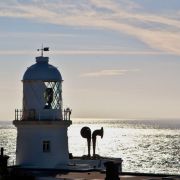Standing on a reef of the same name approximately 10 miles off South East Cornwall’s Rame Head, the Eddystone lighthouse is certainly one of the most famous towers worldwide. The present tower is the 5th to protect these waters and dates from 1882, though there has been a light here since 1698.
The first and second towers were octagonal wooden structures built by a Henry Winstanley, a shipping merchant whose personal experience of the perilous reef and his subsequent losses provoked his efforts to protect other vessels. The first ever lighthouses to be built on a small rock in the open ocean, they lasted a mere five years between them, the second being destroyed by a ferocious storm in 1703 with Winstanley unfortunately inside.
Number three was also made of wood, but its designer, Rudyerd, opted for a smooth-sided conical structure which lasted the best part of 50 years and whose demise came in the form of fire. In his attempts to stop the spread of the flames, the keeper accidentally swallowed a quantity of molten lead dripping from the blazing roof and died, despite having been rescued from the towering inferno. Trinity House's Edinburgh museum still displays the substantial lump of swallowed lead, removed in autopsy.
The following edifice proved to be the most memorable, the most ingenious in terms of engineering and the most enduring. Not only did Smeaton's stone tower last for 120 years, but it was the base rock that started to give way in the end and not the tower itself. Smeaton revolutionised lighthouse building by mimicking the base of an oak tree in its shape and dovetailing the locally sourced granite blocks together. His endeavours also occasioned the need, development and patenting of the world’s first quick-drying cement. The majority of Smeaton’s tower still stands on Plymouth Hoe, its red and white stripes probably the city’s most memorable landmark, having been moved block by block in the late 19th century – the base still stands on the reef beside its successor. Presumably it was to this version of the Eddystone lighthouse that a certain Thomas d'Arcy McGee was referring when he compared Canada’s strong foundations to 'the foundations of Eddystone' in the 1860s.
The present incumbent was designed by Trinity House's James Douglass in 1877. Over a century after the first oak tree shaped tower, its design was a more streamlined version involving even more intricate dovetailing of blocks. Now sporting a helicopter pad on top of the light, the 49 metre tall lighthouse became automatic in the 1980’s.







